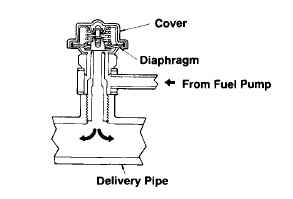FUEL SYSTEM

This above shows the schematics for the fuel delivery system. The fuel is picked up from the gas tank by an electric pump. It is delivered to the two primary fuel injectors (fed from primary fuel rail) and two secondary fuel injectors (fed from secondary fuel rail) under a constant pressure differential (relative to manifold pressure) by means of a fuel pressure regulator. Any excess fuel not injected into the intake is brought back to the tank via a fuel return line. A pulsation damper is mounted on one of the two fuel rails to dampen pressure variations due to the rapid opening and closing of the injectors. The charcoal canister and check-and-cut valve make up the evaporative emission control system which is part of the broader emissions control system.
FUEL PUMP


This above shows the electrical schematics for the fuel pump. The fuel pump is energized when the circuit opening relay's switch is in closed position. This is accomplished when the BR (brown) wire which goes to the Air Flow Meter (AFM) is grounded. When the AFM is operating (engine running), this BR wire is grounded. When the AFM is not operating (engine not running), this BR wire is not grounded and the fuel pump is not energized unless the fuel pump circuit terminal (yellow connector) is shorted with a jumper wire.
Having the fuel pump disabled when the engine is not running is a safety measure. This guarantees that the fuel supply is cut immediately when the engine is shut off whether it is intentional or not. The fuel pump circuit terminal (yellow connector) enables priming and testing of the fuel system without the engine running.
The fuel pump is not on when the ignition switch is at the ON position. It is on only when you crank, that is, the switch is at the START position. The fuel pump keeps on ticking if the car is actually started (air flows through the AFM).
Interesting tidbit: on a turbo 86-88, the actual voltage at the fuel pump is either the full voltage or a lower one. This is controlled by the "fuel pump relay and resistor" relay. By controlling the relay activation and therefore the bypassing of the resistor, the ECU can make the fuel pump operate either at full voltage or at a lower set voltage (to improve fuel economy). There is no such relay on the non turbo model.
FUEL PRESSURE REGULATOR

This above shows the internals of a generic Fuel Pressure Regulator (FPR). The FPR is a diaphragm operated pressure valve. The FPR maintains a constant pressure differential between fuel system pressure and intake manifold pressure. When intake manifold pressure is low (high vacuum), fuel pressure is low. When intake manifold pressure is high (low vacuum), fuel pressure is high. This constant differential guarantees that, for a given pulse to the injectors, the volume of fuel dispensed at the injectors remains constant. In other words, the volume of fuel injected does not depend on engine load (for a given pulse).
Intake manifold vacuum is routed through a pressure regulator control solenoid valve. This solenoid valve is located to the right of the switching solenoid valve (see secondary air injection control system under emssions control system) and behaves similarly. When not energized, it conducts intake vacuum. When energized, it vents (to the atmosphere) the FPR. The pressure regulator control solenoid valve is energized only during a hot start condition. When intake air is hot (as indicated by intake air temperature sensor), the Engine Control Unit (ECU) energizes the solenoid valve and vents the FPR for 90 seconds. When the FPR is vented to the atmosphere (intake manifold pressure is maximum), the fuel pressure is raised to its upper limit (maximum fuel pressure).
At idle, the fuel pressure should be about 28.4 psi. When the FPR is vented to the atmosphere, the fuel pressure should be between 34.1 and 34.9 psi. With engine off, ignition key to the on position, and yellow connector jumped, the fuel pressure should be between 64.0 and 85.3 psi.
PULSATION DAMPER
Because the injectors operate on a pulse, they open and close very rapidly. This may cause undesirable fluctuations in the fuel pressure. The pulsation damper smoothens these fluctuations.

This above shows the internals of a generic pulsation damper. On a mazda rx-7 86-88, the pulsation damper may fail and cause fuel to spill onto the engine, creating a fire hazard. It cannot be stressed enough that pulsation dampers should be checked periodically for leakage.
FUEL INJECTORS
Fuel injectors are turned on and off with a pulse signal. The longer the pulse, the longer the injector stays open and the more fuel is injected. The Engine Control Unit (ECU) provides the pulse signal to the injectors. The injection duration (pulse width) depends upon air mass (entering the engine) and sensor inputs.
The secondary injectors are active only when the rpm are above 3,500 and the engine is under heavy load (heavy acceleration or high speed cruising).

This above shows the Factory Service Manual (FSM) test for proper operation of the secondary injectors. Disconnecting the boost sensor makes the ECU think the intake manifold vacuum is very low (zero) which simulates an heavy load condition.
Copyright © 2003 - The MAZDA RX-7 86-88 Technical Page - All Rights Reserved